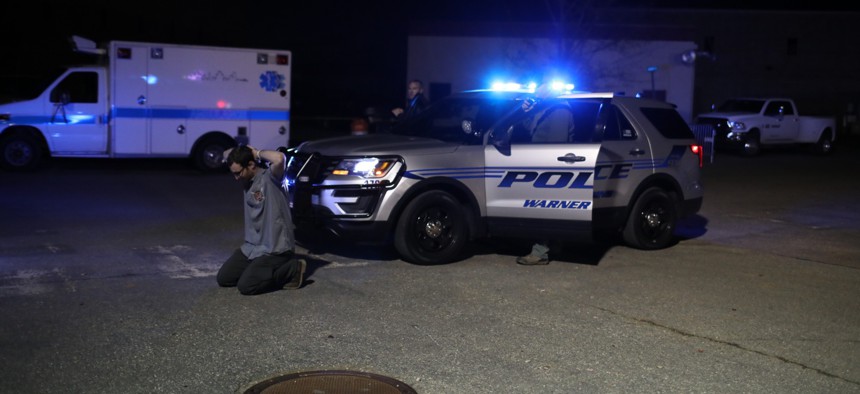sponsor content What's this?
A Testing Ground for Tech: OCR 2019 Explores the Art of the Possible for First Responder Community

First responders demonstrate how technology can be used during a nighttime gas leak simulation at OCR 2019. Verizon
Presented by
Verizon

Two technology giants joined forces to create a unique experience for first responders, bringing together the crisis management community with technology innovators who help empower them to respond to any disaster, natural or manmade.
In its third year, Nokia and Verizon’s Operation Convergent Response (OCR) 2019 drew hundreds of firefighters, emergency responders, dispatchers and technology innovators to the Guardian Centers in Perry, Georgia, Nov. 19 through 21. The event featured technology showcases and an expo floor, but most of the action took place outside at scenarios based on real disasters.
These live demonstrations of crises offered first responders opportunities to witness how technologies work under pressure and in real-world situations.
Gas Leak Scenario Seeks to Showcase Nighttime Challenges, Solutions for First Responders
Among the scenarios, a gas pipeline leak and explosion offered the only immersive scenario to take place at night — and there’s a good reason for it. A nighttime emergency within a cityscape presents a different set of challenges for first responders than a daytime crisis, said Nick Nilan, Verizon’s director of public sector product development.
“Critical infrastructure failures are a potential risk for first responders and communities across the country. This scenario gives our first responders the opportunity to train for an incredibly volatile event with technology specifically suited for the mission,” Nilan said. “A scenario like this allows participants to focus on coordinating a response, with the added complexity and risk of working in the dark.”
The hands-on scenario showcased the way an outdoor gathering can quickly evolve into mayhem. During the scenario, residents convene downtown for a street festival with music, dancing and food. Suddenly, people begin to feel sick; one faints, another keels over in pain. Seconds later, the ground trembles and a blaze lights up the starry sky. A gas pipeline has just exploded.
These events trigger a number of technologies into action. Chemical, biological, radiological, nuclear and explosive (CBRNE) sensors in the ground and on street poles identify minute changes in air pressure and chemicals in the atmosphere. These sensors alert first responders and send continuous updates to a situational awareness tool that offers first responders a common operating picture of the incident to aid in quick decision-making.
“Leaders across any enterprise want the ability to visualize information in a clearer picture, to help enable them to make decisions faster and more effectively,” Nilan said. “The direct integration of sensor intelligence into a common operating picture allows for automated alerting and information sharing for everyone involved in the response, helping lead to a swifter, safer response.”
Airborne technology also assists first responders. Drones equipped with infrared cameras fly over the affected area, offering responders a picture of activity on the ground.
“Each of the first responders has a tablet and a phone so they can get the live images in the dark of what the drone sees overhead,” Nilan said. “These drones give them a visual at a safe distance.”
This particular scenario highlighted how first responders can better leverage the technology they already have in order to effectively and efficiently obtain the information they need to make informed decisions, Nilan said.
It’s also important to protect the data and devices with software to lock down the information in the event a device is lost or stolen.
“One of the things we've seen in the past is people stealing or breaking in to police vehicles, and then the laptop is up and running, and now they have all the information that the police officers have,” Nilan said. A virtualized tablet with no data residing on the device itself can ensure that thieves don’t get their hands on sensitive information.
Integrating Technology — and People
The gas leak scenario requires multiple technologies across multiple vendors to work together — just like first responders need in real life to respond quickly and effectively. OCR involves about 130 technology partners and puts a selection of new tools to the test for the first time. The challenge is integrating all the devices, data and software — old and new alike, said Jad Muntasser, asymmetric solutions manager at Verizon.
“It's interoperability, making sure it all works together,” said Muntasser. “If you think you're going to come to a disaster, a real disaster, and just do whatever it is your product does in ideal conditions, you've never been to a real crisis. It’s literally a collaborative environment because there's no other choice. We've seen some great collaboration here. We're solving problems as we prepare for this.”
Technology aside, interoperability has a human factor, too.
A former Navy SEAL and special operations medic, Muntasser helps the technology partners work together during the training missions. He describes OCR as a testbed for emerging technologies and new concepts. Ultimately, the event brings first responders further up the development lifecycle so they can provide feedback on how technologies actually work in the field and whether there are any beneficial modifications vendors can make to current products.
“It's a win for everybody,” Muntasser said. “It's a win for the first responders because they have a product they're going to use that they had some input on. It's a win for the product developers because they're going to sell more products. And we win because we put people together, and we're actually helping to save lives.”
Learn more about how first responders tapped tech at OCR 2019 to tackle wildfires, cyberattacks and an airport in crisis.
This content is made possible by our sponsor. The editorial staff was not involved in its preparation.
NEXT STORY: When Cyberattacks Turn Physical, Tech Proves Vital to Response at OCR 2019





